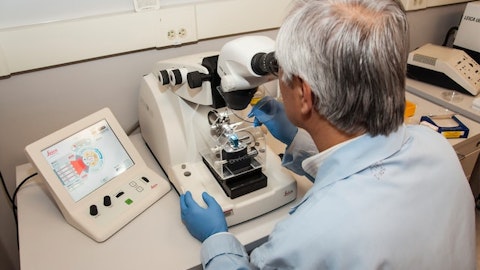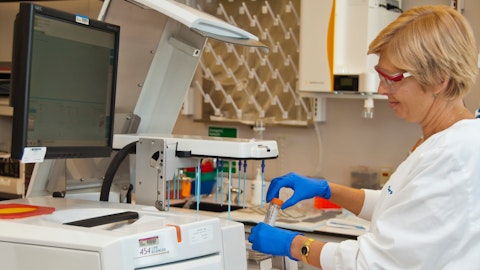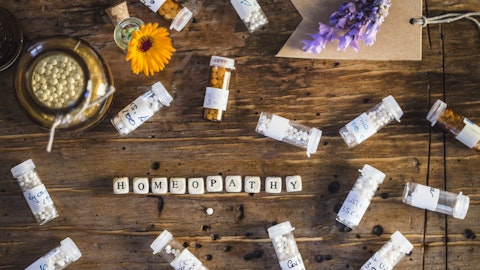Christophe Weber: Okay. Wakao-san, I think we, obviously, will give next year guidance in May next year. But I think there are very two important parameters that are important to consider. One is that the launch of the subcu will certainly deleverage overall. And so we expect a very significant positive impact on the overall brand. I mentioned earlier that around 35% to 40% of the U.S. market is a subcu formulation market. So it will allow us to compete in this segment that we didn’t have access to in the past. So that’s one. And two, it will be very interesting to see how the overall market is evolving. We believe that new patient treatment initiation is still quite low. The market growth in volume has been quite lower than what we expected.
We know that we are not at the pre-COVID in terms of new treatment initiations. It would be very interesting to see if things will remain like that and we will see a rebound. So overall, I would suspect that we will see an increased growth. I will let Julie mention the situation and the competition. Obviously, there is a lot of competition. We can zoom on the U.S. But before that, I would like to mention that ENTYVIO is also growing very well outside of the U.S., in Europe, in China, in Japan. Julie, perhaps you can comment on the competition?
Julie Kim: Yes. Thanks, Christophe. And thank you for the question, Wakao-san. In terms of the competition in the U.S., as you’ve rightly pointed out, there is increased competition through new entrants. And even yesterday, there was an announcement of a new entrant from Celltrion. So we continue to see multiple different mechanisms of actions entering into the IBD space. But ENTYVIO continues to be the only gut-selective MOA, and it continues to be a market share leader in terms of overall [Indiscernible] share, as well as overall IBD market share. So this is an area where we will continue to emphasize the benefits of ENTYVIO in the IBD space. And with the launch of the subcutaneous formulation ENTYVIO Pen, we’re quite confident in our ability to continue to support ENTYVIO growth in the U.S. despite new entrants coming in.
Seiji Wakao: Thank you. Understood.
Unidentified Company Representative: [Foreign Language] [Interpreted] Next question from Jefferies, Steve Barker-san. You can go ahead.
Steve Barker: Yes, Steve Barker here. Thanks very much for taking my question. I have two questions for Andy related to your narcolepsy candidate, TAK-861. Specifically, I wanted to ask about the Phase I results that were presented at World Sleep this week. Firstly, could you discuss the doses that were tested in Phase I in the context of the Phase II program? And secondly, are you concerned that TAK-861 might be at a commercial disadvantage if it needs to be dose twice per day. The context of the second question is, of course, the data presented on the [Indiscernible], Orexin agonist, which looks like it can be developed as a once per day therapy. Thank you.
Andy Plump: Hi, Stephen, I’ll take the first question, and then I’ll ask Ramona to chime in if she can on the commercial positioning of a once versus a twice daily dosing. So the Phase Ib data that we presented at the Sleep conference just this week, was really very small numbers, really proof of concept. The doses that we’ve used in our Phase IIb studies are significantly lower than what you saw this week. And then lastly, I’ll say that we haven’t decided on our dosing regimen yet for our Phase III program. That’s something that we’ll decide after we see our full Phase IIb data. And I think that we have to be cautious when we’re looking at any data set, ours or competitors, from small Phase Ib studies in terms of understanding what administration schedules will look like. Ramona?
Ramona Sequeira: Yes, Andy, I can chime in on the efficacy. And we had a very large team at the Sleep conference this week and are very excited about the Orexin franchise that we have at Takeda. For TAK-861, we still believe it’s going to be the first-in-class and the best-in-class to treat narcolepsy. And as we do research with physicians and patients really around the world most importantly in the U.S. as well. There is such a high need for better treatment options to really help people live a more functional life with narcolepsy. And so it’s always going to be a trade-off with the dosing and the actual functionality that we can get. And so we are very confident that whatever profile we go for with dosing will be to really maximize functionality in these patients. And as Andy said, it’s early days to say now exactly how we’re going to plan to do that, but we’re very confident in our target product profile for TAK-861.
Steve Barker: Thanks. Just one quick follow-up. Regarding the safety. So you were testing very large doses in this first — in this Phase I, versus what you are testing in Phase II. And the safety profile looks very good. Does that give you — how do you — does that improve your confidence about the safety of this asset?
Andy Plump: The more — Stephen, the more experience we have, the more — the stronger we feel about the safety profile of TAK-861. And I’ll just reiterate something I said during the presentation, which is that we’ve now enrolled 180 patients approximately in between the two Phase IIb studies. We’ve had — we’ve obviously been very cautious around all safety parameters, especially liver function tests, and we have an independent data safety monitoring board that’s been tracking. And we haven’t seen any signals consistent with liver toxicity. And it’s very consistent with the margins that we have and the doses that we’re using. So we feel quite good about the overall safety and tolerability profile at this point.
Steve Barker: Thank you.
Unidentified Company Representative: [Foreign Language] [Interpreted] Hashiguchi-san, please ask your question.
Kazuaki Hashiguchi: [Foreign Language] [Interpreted] Yes, this is Hashiguchi. TAK-291 Phase II data, psoriatic arthritis, I see a presentation, I actually read the abstract of this presentation. And sotic 2 data compared to that data. And I believe that the efficacy is actually about the same. And AEs Adverse Events about the same in low dose. And in higher dose, TAK-279 has a higher incidence of AEs, it seems. I understand it’s a different population. And I want to understand how to interpret the data from this study. And for TAK-279, how do you assess the competitiveness of this compound? That’s my question.
Christopher O’Reilly: Thank you, Hashiguchi-san for the question. So a question on the TAK-279 psoriatic arthritis Phase II abstract that was recently published. Andy, your thoughts on that?




